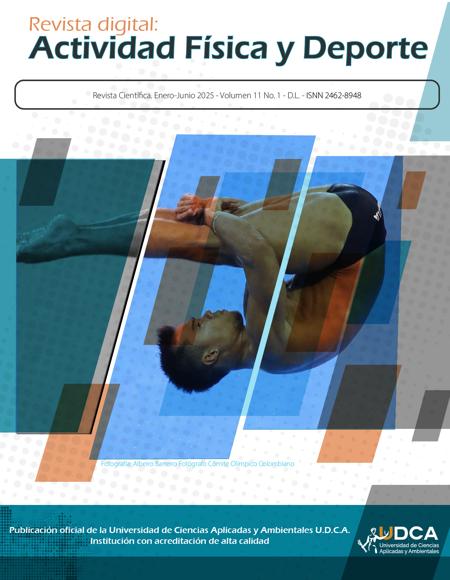Descripción de dos protocolos de velocidades repetidas en futbolistas juveniles
Description of two protocols of the repeated sprint ability of young soccer players
Contenido principal del artículo
Resumen
Introducción: la evaluación del rendimiento físico de futbolistas en edades jóvenes es de gran importancia en el desarrollo del jugador a largo plazo. Objetivo: describir el resultado de dos protocolos de repetición de sprints RSA, compuestos de diferentes distancias, repeticiones y tiempos de recuperación, en futbolistas juveniles, de nivel competitivo. Materiales y métodos: luego de evaluar una antropometría básica, 25 futbolistas realizaron la prueba RSA 10x20-20” y otros 25 futbolistas, la prueba RSA 7x35-25”; todos los jugadores, entre las edades 14,77 y 15,32 años y participantes del mismo nivel competitivo. Para el análisis de la información se realizó una figura de distribución de tiempos individuales, según el protocolo en el que participó; se calcularon los índices de fatiga y declive de rendimiento DR, así como una estadística descriptiva y múltiples correlaciones de Spearman para cada protocolo ,de manera independiente. Resultados y discusión: el RSA 10x20-20” tuvo una distribución de resultados más estable; también presentó más elevados el índice de fatiga, comparados con el 7x35-25”. Conclusiones: el tiempo total de trabajo y la variabilidad individual de cada futbolista fue más elevada en el protocolo 7x35-25” que el10x20-20”; sin embargo, el RSA 10x20-20” tuvo más elevado el índice de fatiga y el decline de rendimiento. El control de carga interna es necesario para dosificar adecuadamente la distancia, la repetición y la recuperación en el RSA, en futbolistas adolescentes
Palabras clave:
Descargas
Detalles del artículo
Referencias (VER)
ASÍN IZQUIERDO, I.; GUTIÉRREZ GARCÍA, L.; RAYA-GONZÁLEZ, J.; CASTILLO, D.; SÁNCHEZ-SÁNCHEZ, J.; RODRÍGUEZ FERNÁNDEZ, A. 2021. Entrenamiento mediante sprints repetidos en futbolistas: Efectos sobre la capacidad de repetir sprint, salto y tiempo de reacción. Cultura, ciencia y deporte. 17(16):337-345. https://doi.org/10.12800/ccd.v16i49.1264 DOI: https://doi.org/10.12800/ccd.v16i49.1264
BARBERO-ÁLVAREZ, J.C.; PEDRO, R.E.; NAKAMURA, F.Y. 2013. Validity of a repeated-sprint ability test in young soccer players. Science & Sports. 28(5):e127–e131. https://doi.org/10.1016/j.scispo.2012.12.003 DOI: https://doi.org/10.1016/j.scispo.2012.12.003
BISHOP, D.; SPENCER, M.; DUFFIELD, R.; LAWRENCE, S. 2001. The validity of a repeated sprint ability test. Journal of science and medicine in sport. 4(1):19-29. https://doi.org/10.1016/s1440-2440(01)80004-9 DOI: https://doi.org/10.1016/S1440-2440(01)80004-9
CAMPA, F.; SEMPRINI, G.; JÚDICE, P.B.; MESSINA, G.; TOSELLI, S. 2018. Anthropometry, physical and movement features, and repeated-sprint ability in soccer players. International Journal of Sports Medicine. 40(02):100-109. https://doi.org/10.1055/a-0781-2473 DOI: https://doi.org/10.1055/a-0781-2473
CAMPILLO, P.; NKUIGNIA, O.; MATÍAS LÓPEZ, C. 2013. Maximal aerobic speed tests with young footballers. monitoring and scheduling training intensity. Apunts. Educación Física y Deportes. 113:45-51. http://dx.doi.org/10.5672/apunts.2014-0983.es.(2013/3).113.04 DOI: https://doi.org/10.5672/apunts.2014-0983.es.(2013/3).113.04
CASTAGNA, C.; KRUSTRUP, P.; D’OTTAVIO, S.; POLLASTRO, C.; BERNARDINI, A.; PÓVOAS, S.C.A. 2019. Ecological validity and reliability of an age-adapted endurance field test in young male soccer players. The Journal of Strength & Conditioning Research. 33(12):3400-3405. https://doi.org/10.1519/JSC.0000000000002255 DOI: https://doi.org/10.1519/JSC.0000000000002255
CASTAGNA, C.; MANZI, V.; IMPELLIZZERI, F.; WESTON, M.; ALVAREZ, J.C.B. 2010. Relationship between endurance field tests and match performance in young soccer players. The Journal of Strength & Conditioning Research. 24(12):3227-3233. https://doi.org/10.1519/JSC.0b013e3181e72709 DOI: https://doi.org/10.1519/JSC.0b013e3181e72709
CHAOUACHI, A.; MANZI, V.; WONG, D.P.; CHAALALI, A.; LAURENCELLE, L.; CHAMARI, K.; CASTAGNA, C. 2010. Intermittent endurance and repeated sprint ability in soccer players. The Journal of Strength & Conditioning Research. 24(10):2663-2669. https://doi.org/10.1519/JSC.0b013e3181e347f4 DOI: https://doi.org/10.1519/JSC.0b013e3181e347f4
CHARRON, J.; VELIZ GARCIA, J.; ROY, P.; FERLAND, P.-M.; COMTOIS, A. 2020. Physiological responses to repeated running sprint ability tests: A systematic review. International Journal of Exercise Science 13(4):1190-1205. https://pubmed.ncbi.nlm.nih.gov/33042370/ DOI: https://doi.org/10.70252/NXQI1037
CLEMENTE SUÁREZ, V.; MUÑOZ, V.E.; MELÚS, M. 2011. Fatiga del sistema nervioso después de realizar un test de capacidad de sprints repetidos (RSA) en jugadores de fútbol profesionales. Archivos de Medicina del Deporte. 28(143):174-180. DOI: https://doi.org/10.1016/j.apunts.2011.04.003
DA SILVA, J.F.; GUGLIELMO, L.G.; BISHOP, D. 2010. Relationship between different measures of aerobic fitness and repeated-sprint ability in elite soccer players. the journal of strength & conditioning research. 24(8):2115–2121. https://doi.org/10.1519/JSC.0b013e3181e34794 DOI: https://doi.org/10.1519/JSC.0b013e3181e34794
DAL PUPO, J.; PORTO ALMEIDA, C.M.; DETANICO, D.; FERNANDES DA SILVA, J.; ANTONACCI GUGLIELMO, L.G.; DOS SANTOS, S.G. 2010. Potência muscular e capacidade de sprints repetidos em jogadores de futebol. Revista Brasileira de Cineantropometria & Desempenho Humano. 12:255-261. https://doi.org/10.5007/1980-0037.2010V12N4P255 DOI: https://doi.org/10.5007/1980-0037.2010v12n4p255
DUARTE, J.P.; COELHO-E-SILVA, M.J.; COSTA, D.; MARTINHO, D.; LUZ, L.G.O.; REBELO-GONÇALVES, R.; VALENTE-DOS-SANTOS, J.; FIGUEIREDO, A.; SEABRA, A.; MALINA, R.M. 2019. Repeated sprint ability in youth soccer players: Independent and combined effects of relative age and biological maturity. Journal of human kinetics. 67.209-221. https://doi.org/10.2478/hukin-2018-0090 DOI: https://doi.org/10.2478/hukin-2018-0090
DUPUY, A.; BIRAT, A.; MAURELLI, O.; GARNIER, Y.M.; BLAZEVICH, A.J.; RANCE, M.; RATEL, S. 2022. Post-exercise heart rate recovery and parasympathetic reactivation are comparable between prepubertal boys and well-trained adult male endurance athletes. European Journal of Applied Physiology. 122(2):345-355. https://doi.org/10.1007/s00421-021-04823-0 DOI: https://doi.org/10.1007/s00421-021-04823-0
FAUDE, O.; KOCH, T.; MEYER, T. 2012. Straight sprinting is the most frequent action in goal situations in professional football. Journal of Sports Sciences. 30(7):625-631. https://doi.org/10.1080/02640414.2012.665940 DOI: https://doi.org/10.1080/02640414.2012.665940
GIRARD, O.; MENDEZ-VILLANUEVA, A.; BISHOP, D. 2011. Repeated-sprint ability - part I: Factors contributing to fatigue. Sports Medicine. 41:673-694. https://doi.org/10.2165/11590550-000000000-00000 DOI: https://doi.org/10.2165/11590550-000000000-00000
GUALTIERI, A.; RAMPININI, E.; DELLO IACONO, A.; BEATO, M. 2023. High-speed running and sprinting in professional adult soccer: current thresholds definition, match demands and training strategies. a systematic review. Frontiers in sports and active living. 5:1116293. https://doi.org/10.3389/fspor.2023.1116293 DOI: https://doi.org/10.3389/fspor.2023.1116293
HARRISS, D.J.; MACSWEEN, A.; Y ATKINSON, G. 2019. Ethical standards in sport and exercise science research: 2020 update. International Journal of Sports Medicine. 40(13):813-817. https://doi.org/10.1055/a-1015-3123 DOI: https://doi.org/10.1055/a-1015-3123
IAIA, F.M.; RAMPININI, E.; BANGSBO, J. 2009. High-intensity training in football. International Journal of Sports Physiology and Performance. 4(3):291–306. https://doi.org/10.1123/ijspp.4.3.291 DOI: https://doi.org/10.1123/ijspp.4.3.291
IRIGOYEN, J.Y.; AZCARATE, U.; LOS ARCOS, A. 2017. Análisis de la capacidad de realizar esprines repetidos con y sin cambio de dirección en futbolistas profesionales. SPORT TK-Revista EuroAmericana de Ciencias del Deporte. 6(1):51-56. https://doi.org/10.6018/280401 DOI: https://doi.org/10.6018/280401
KARAKOÇ, B.; AKALAN, C.; ALEMDAROĞLU, U.; ARSLAN, E. 2012. The relationship between the Yo-Yo tests, anaerobic performance and aerobic performance in young soccer players. Journal of Human Kinetics. 35:81-88. https://doi.org/10.2478/V10078-012-0081-X DOI: https://doi.org/10.2478/v10078-012-0081-x
KYLES, A.; OLIVER, J.L.; CAHILL, M.J.; LLOYD, R.S.; PEDLEY, J. 2023. Linear and change of direction repeated sprint ability tests: a systematic review. Journal of Strength and Conditioning Research. 37(8):1703–1717. https://doi.org/10.1519/jsc.0000000000004447 DOI: https://doi.org/10.1519/JSC.0000000000004447
LOTURCO, I.; JEFFREYS, I.; KOBAL, R.; CAL ABAD, C.C.; RAMIREZ-CAMPILLO, R.; ZANETTI, V.; PEREIRA, L.A.; NAKAMURA, F.Y. 2018. Acceleration and speed performance of Brazilian elite soccer players of different age-categories. Journal of Human Kinetics. 64(1):205-218. https://doi.org/10.1515/hukin-2017-0195 DOI: https://doi.org/10.1515/hukin-2017-0195
MASCHERINI, G.; GALANTI, G.; STEFANI, L.; IZZICUPO, P. 2023. Normative values for heart rate response to exercise in young athletes at 10-18 years old. European journal of sport science. 23(7):1186–1193. https://doi.org/10.1080/17461391.2022.2086490 DOI: https://doi.org/10.1080/17461391.2022.2086490
NUGHES, E.; RAGO, V.; AQUINO, R.; ERMIDIS, G.; RANDERS, M.B.; ARDIGÒ, L.P. 2020. Anthropometric and Functional Profile of Selected vs. Non-Selected 13-to-17-Year-Old Soccer Players. Sports. 8(8):111. https://doi.org/10.3390/sports8080111 DOI: https://doi.org/10.3390/sports8080111
PARRA TIJARO, K.; PARRA TIJARO, M.; MAYORGA OSORIO, D.A.; DIMATE, M.A.; CELIS, J.M. 2024. Incidencia de la potencia de miembros inferiores sobre la velocidad de remate en futbolistas juveniles. Revista Peruana de Ciencias de la Actividad Física y del Deporte: RPCAFD. 11(2):1916-1924.
PARRA-TIJARO, M.; PARRA TIJARO, K.; PARRA JIMENÉZ, J.; DIMATE, M.; CELIS, J. 2022. Comparación de la aptitud física entre jóvenes futbolistas colombianos. Ciencias De La Actividad Física UCM. 23(2):1-14. https://doi.org/10.29035/rcaf.23.2.7 DOI: https://doi.org/10.29035/rcaf.23.2.7
RAMPININI, E.; SASSI, A.; MORELLI, A.; MAZZONI, S.; FANCHINI, M.; COUTTS, A.J. 2009. Repeated-sprint ability in professional and amateur soccer players. Applied Physiology, Nutrition, and Metabolism. 34(6):1048-1054. https://doi.org/10.1139/h09-111 DOI: https://doi.org/10.1139/H09-111
SÁNCHEZ-SÁNCHEZ, J.; HERNÁNDEZ FAMILIAR, C.; MUÑOZ, V.M.; GONZÁLEZ GARCÍA, A.; RODRÍGUEZ FERNÁNDEZ, A.; CARRETERO GONZÁLEZ, M. 2016. Efecto de un entrenamiento intermitente con y sin cambios de dirección, sobre el rendimiento físico de jóvenes futbolistas. RETOS. Nuevas Tendencias en Educación Física, Deporte y Recreación. 30:70-75. DOI: https://doi.org/10.47197/retos.v0i30.38463
SANDERS, G.J.; TURNER, Z.; BOOS, B.; PEACOCK, C.A.; PEVELER, W.; LIPPING, A. 2017. Aerobic capacity is related to repeated sprint ability with sprint distances less than 40 meters. International Journal of Exercise Science. 10(2):197. https://doi.org/10.15314/tjse.201428101 DOI: https://doi.org/10.70252/GCDN2088
SLAUGHTER, M.H.; LOHMAN, T.G.; BOILEAU, R.A.; HORSWILL, C.A.; STILLMAN, R.J.; VAN LOAN, M.D.; BEMBEN, D.A. 1988. Skinfold equations for estimation of body fatness in children and youth. Human Biology. 60(5):709-723.
SPENCER, M.; FITZSIMONS, M.; DAWSON, B.; BISHOP, D.; GOODMAN, C. 2006. Reliability of a repeated-sprint test for field-hockey. Journal of science and medicine in sport. 9(1-2):181-184. https://doi.org/10.1016/j.jsams.2005.05.001 DOI: https://doi.org/10.1016/j.jsams.2005.05.001
STOLEN, T.; CHAMARI, K.; CASTAGNA, C.; WISLOFF, U. 2005. Physiology of soccer. Sports medicine. 35.501-36. https://doi.org/10.2165/00007256-200535060-00004 DOI: https://doi.org/10.2165/00007256-200535060-00004
THURLOW, F.; HUYNH, M.; TOWNSHEND, A.; MCLAREN, S.J.; JAMES, L.P.; TAYLOR, J.M.; WESTON, M.; WEAKLEY, J. 2024. The effects of repeated-sprint training on physical fitness and physiological adaptation in athletes: A systematic review and meta-analysis. Sports medicine. 54(4):953-974. https://doi.org/10.1007/s40279-023-01959-1 DOI: https://doi.org/10.1007/s40279-023-01959-1








